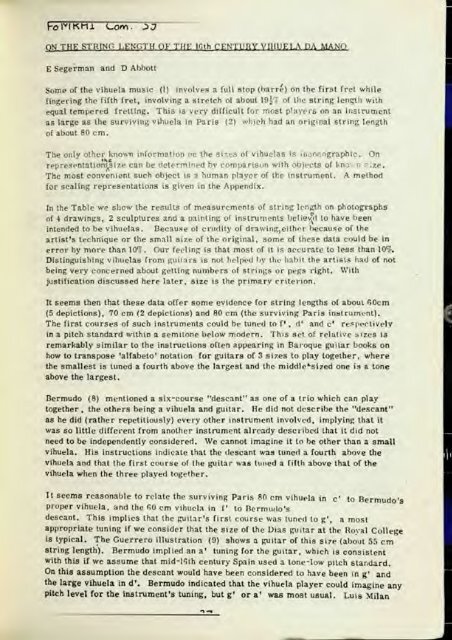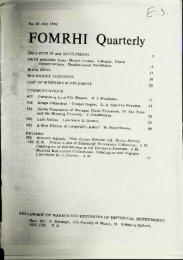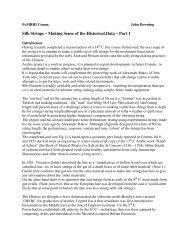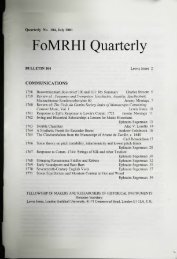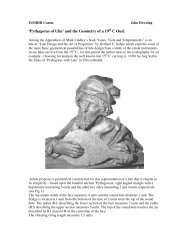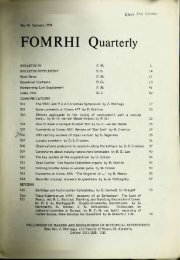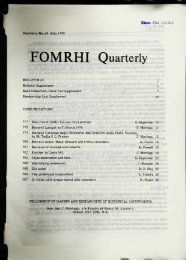•rf - FoMRHI
•rf - FoMRHI
•rf - FoMRHI
Create successful ePaper yourself
Turn your PDF publications into a flip-book with our unique Google optimized e-Paper software.
-ol v lr\rll Low. 23<br />
ON THE STRING LENGTH OF THE lOth CENTURY VniUELA DA MANO<br />
E Segerman and D Abbott<br />
Some of the vihuela music (1) involves a full stop (barre) on the first fret while<br />
fingering the fifth fret, involving a stretch of about 19^ of the string length with<br />
equal tempered fretting. This is very difficult for most players on an instrument<br />
as large as the surviving vihuela in Paris (2) which had an originai string length<br />
of about 80 cm.<br />
The only other known information or. the sizes of vihuelas is inconographic. On<br />
representation^size can be determined by comparison with objects of known ~ize.<br />
The most convenient such object is a human player of the instrument. A method<br />
for scaling representations is given in the Appendix.<br />
In the Table we show the results of measurements of string length on photographs<br />
of 4 drawings, 2 sculptures and a painting of instruments believd to have been<br />
intended to be vihuelas. Because of crudity of drawing,either because of the<br />
artist's technique or the small size of the originai, some of these data could be in<br />
error by more than 10^. Our feeling is that most of it is accurate to less than 10%.<br />
Distinguishing vihuelas from guitars is not helped by the habit the artisls had of not<br />
being very concemed about getting numbers of strings or pegs right. With<br />
justification discussed here later, size is the primary criterion.<br />
It seems then that these data offer some evidence for string lengths of aboul 60cm<br />
(5 depictions), 70 cm (2 depictions) and 80 cm (the surviving Paris instrument).<br />
The first courses of such instruments could be tuned to P, d' and e' respectively<br />
in a pitch standard within a semitone below modem. This set of relative sizes is<br />
remarkably similar to the instructions often appearing in Baroque guitar books on<br />
how to transpose 'alfabeto' notation for guitars of 3 sizes to play together, where<br />
the smallest is tuned a fourth above the largest and the middle*-sized one is a tone<br />
above the largest.<br />
Bermudo (8) mentioned a six-course "descant" as one of a trio which can play<br />
together, the others being a vihuela and guitar. He did not describe the "descant"<br />
as he did (rather repetitiously) every other instrument involvcd, implying that it<br />
was so little different from another instrument already described that it did not<br />
need to be independently considered. We cannot imagine it to be other than a small<br />
vihuela. His instructions indicate that the descant was tuned a fourth above the<br />
vihuela and that the first course of the guitar was tuned a fifth above that of the<br />
vihuela when the three played together.<br />
It seems reasonable to relate the surviving Paris 80 cm vihuela in e' to Bermudo's<br />
proper vihuela, and the 60 cm vihuela in f to Bermudo's<br />
descant. This implics that the guitar's first course was tuned to g', a most<br />
appropriate tuning if we consider that the size of the Dias guitar at the Royal College<br />
is typical. The Guerrero illustration (9) shows a guitar of this size (about 55 cm<br />
string length). Bermudo implied an a' tuning for the guitar, which is consistent<br />
with this if we assume that mid-16th century Spain used a tone-low pitch standard.<br />
On this assumption the descant would have been considered to have been in g' and<br />
the large vihuela in d\ Bermudo indicated that the vihuela player could imagine any<br />
pitch level for the instrument's tuning, but g' or a' was most usuai. Luis Milan


